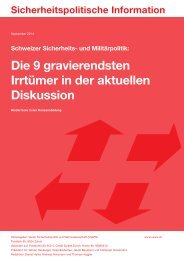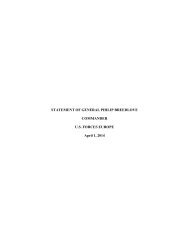FULLTEXT01
FULLTEXT01
FULLTEXT01
You also want an ePaper? Increase the reach of your titles
YUMPU automatically turns print PDFs into web optimized ePapers that Google loves.
TACTICAL THOUGHT<br />
2014 September 29 th<br />
It is possible to label the content in the model according to commonly known military<br />
unit names, each in relation to a context character. This results in the four tactical types;<br />
Ranger tactics in a Regular Warfare context, Mechanized tactics in Regular Warfare,<br />
Infantry tactics in Hybrid Warfare and finally Mechanized tactics in Hybrid Warfare.<br />
This division is to be seen in principal because overlapping exists and strict boundaries<br />
can be discussed.<br />
The result was presented to Ms Brigitte LeRoux 175 during a seminar at the Swedish<br />
National Defence College (SNDC) on 28 January 2013. The MCA result was viewed as<br />
strong. The seminar was a co-arrangement between Uppsala University SEC 176 and<br />
SNDC.<br />
Discussion on differences in the tactical model<br />
The labelling of tactical types with traditional military unit labels indicates differences.<br />
In order to explain some principal differences in broad terms, the so-called basic<br />
capabilities have been used. 177 They consist of; Command and Control, Intelligence/<br />
Information, Protection, Sustainability, Mobility and Effects on targets. Requirements<br />
of these capabilities are argued to be militarily usually viewed differently, depending on<br />
what contexts and concepts are being discussed. This is supported by the existence of<br />
doctrines and field manuals for different units and different contexts. In order to give an<br />
overview of a way to outline principal differences of the four tactical types, the figure<br />
on the next page has been made. The summarized characteristics draw from my own<br />
understanding and experience of studies of warfare and war fighting capabilities. The<br />
characteristics are to be seen as indicators of broad directions.<br />
175 Brigitte LeRoux is Maitre de Conférences at the Laboratoire de Mathématiques Appliquées (MAP 5),<br />
CNRS (the French National Centre for Scientific Research) Université Paris Decartes and associated<br />
researcher at the political research centre of Science-Po Paris (CEVIPOF/CNRS). She is a world leading<br />
expert in GDA and has contributed to numerous theoretical research works and full-scale empirical<br />
studies involving GDA. She has been Doctor Honoris Causa at Uppsala University since 2013, as<br />
recognition of her work, including substantial support to the development of sociological research at<br />
Uppsala University.<br />
176 SEC, Sociology of Education and Culture is a research unit with numerous disciplines within the social<br />
sciences and humanities. It is affiliated with several departments, primarily at Uppsala University. SEC is<br />
a node in Scandinavia for research in the vein of certain French traditions founded by Pierre Bourdieu,<br />
Jean-Paul Benzécri and others. The research areas include studies on cultural fields, history of education,<br />
formation of elites, students’ trajectories, and transnational transformations of the educational and cultural<br />
fields. There is also methodologically oriented work on geometric data analysis and prosopographical<br />
methods. Important research tools are concepts such as capital and field. Prosopographical methods and<br />
geometric data analyses are frequently used. Historical perspectives are crucial.<br />
http://www.skeptron.uu.se/broady/sec/<br />
177 Reglemente för Markoperationer, (RMO), remiss 3 (2009), pp. 59-61.<br />
76





